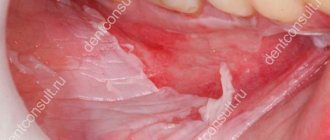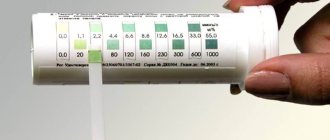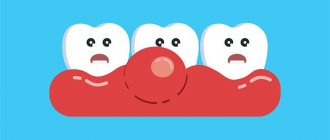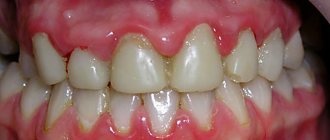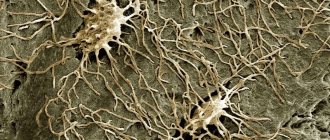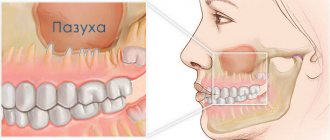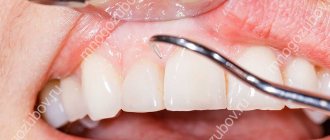Hyperplastic gum growth is a fairly pressing problem in dentistry that requires timely professional treatment. This condition not only spoils the appearance of the teeth, but also causes discomfort and can become complicated. gum hypertrophy develops, it is recommended to immediately consult a dentist. The Nurimed clinic in St. Petersburg offers its services for the diagnosis and treatment of overgrown periodontal tissue.
Causes of gum overgrowth
Establishing factors that contribute to an increase in periodontal volume makes it possible to reduce the risk of recurrence of an unpleasant situation and draw up a competent treatment plan.
The main causes of gum hyperplasia:
- inflammatory process in the gingival area;
- mechanical damage to soft tissues;
- taking certain medications (immunosuppressants, anticonvulsants, antihypertensive drugs - calcium channel blockers);
- the presence of certain systemic pathologies (hormonal imbalances, metabolic disorders, systemic connective tissue diseases, leukemia);
- oncological processes in the body;
- accumulation of tartar in the cervical part of the tooth crown;
- increased spaces between teeth or teeth growing at an angle;
- complication of gingivitis, periodontitis.
Reasons for appearance
Gum overgrowth can be a consequence of taking certain medications. There are a number of studies that have proven that periodontal hyperplasia is a consequence of taking antibiotics and other medications. In all the cases studied, either the dosage of the medications was violated, or the patient self-medicated, that is, he prescribed medications for himself, without consulting a specialist.
Other reasons include:
- genetics: in this case, the pathology manifests itself already at a young age, as a rule, at the time of the eruption of milk and then molars;
- hormonal changes in the body during pregnancy;
- blood diseases;
- incorrect structure of the maxillofacial apparatus.
Types of gum hyperplasia
In dentistry, the following types of fibromatosis are distinguished:
- Localized hyperplasia (tissue near one tooth or group of teeth is affected).
- Generalized (the entire dentition of one or both jaws overlaps).
- Papillary (growth is concentrated only in the area of the papillary papilla).
- Marginal (not only the papilla is affected, but also the gingival margin).
- Diffuse (increase in all layers and areas of tissue).
In some cases, hypertrophy appears as a bump or growth when the growth affects a limited area.
What symptoms can be used to identify hypertrophy?
You can see the increased size of the gums visually. Hyperplasia is a non-inflammatory disease that can occur in both adults and children.
The first and most important symptom is the growth of gums, which seem to be on the tooth. This can be observed in the area of one tooth, between dental units, or throughout the entire jaw. In this case, the mucous membrane may not change its color, but may become bright red, and even turn a little blue. Patients with hypertrophy speak not only about the aesthetic disadvantage of the periodontium, but also about the occurrence of difficulties when chewing food, and pain when pressing on the gums.
Pathology can occur not only in humans, but also in cats and dogs. However, hyperplasia in animals is not contagious and is caused by other reasons.
Manifestations of the disease
The following clinical symptoms allow you to recognize gum fibromatosis:
- In the initial stages, swelling or enlargement of tissue of a tumor nature.
- On the mucous membrane you can see thickenings that gradually increase.
- Increased gum volume without signs of swelling.
- Filling interdental spaces with soft tissue.
- Overlapping of the teeth with the edges of the gums.
- Injury to overgrown areas during cleaning (this can cause bleeding and inflammation).
- Increasing intensity of tissue color (the gums become bright pink).
If you notice any signs of fibromatosis, you should immediately contact your dentist. If you ignore the problem, unpleasant complications may develop:
- decreased quality of daily hygiene with an increased risk of developing infections;
- pain when eating;
- redistribution of chewing load;
- development of periodontal diseases.
Causes and symptoms of hyperplasia
The first sign of pathology is a feeling of swelling of the gum tissue, a change in the color of the gums and filling of the interdental spaces with increased tissue. Subsequently, the tumor covers part of the tooth.
The causes of this pathology are not clear. Perhaps the disease is genetic in nature and accompanies hormonal changes in the body. The first manifestation of hereditary gum disease is swelling of the gingival papillae during teething in an infant.
Taking medications can also trigger hypertrophy. In this case, the disease is not fibrotic in nature. Other causes of pathology:
during puberty; during pregnancy; with malocclusion; with an abnormal arrangement of the dentition; for diseases of the hematopoietic system; in the absence of oral hygiene: stones, plaque on the teeth.
What medications can provoke the growth of gingival papillae? Hyperplasia may occur when taking cyclosporine and phenytoin. According to medical observations, pathology can also appear as a consequence of uncontrolled use of hormonal drugs, as well as calcium channel blockers.
The cause of hypertrophy can be a decrease in immunity against the background of infectious inflammatory processes in the body. With the medicinal form of hyperplasia, bleeding red nodules appear, which grow over time and cover a significant part of the tooth surface.
The mechanism of manifestation of the disease is not fully understood. The clinical picture consists of the following elements. The basis of connective tissue is collagen. Healthy gum connective tissue grows slower than normal gum cells. With a pathological change in the soft tissue of the gums, the active proliferation of connective tissue cells begins, which produces a large amount of collagen and other elements. It is collagens that fill the internal space of fibromatous tissue, forming a tumor.
Mechanism of development of hyperplasia
The mechanism of development of the hypertrophic process remains not fully understood. However, scientists have discovered that the pathogenesis of the disease is influenced by impaired calcium transport. This leads to increased production of collagenase, which causes the gums to grow. Hyperplasia develops gradually, so patients do not pay attention to it right away.
Stages of the disease:
- First: the tissue covers a third of the tooth, there are no signs of an inflammatory process.
- Second: covers half of the tooth, bleeding may occur, especially with mechanical impact.
- Third: overlap from two-thirds to the entire crown, sometimes even the cutting edge and chewing surface are covered with soft tissue, granulations are visible over the entire surface.
Development of gingival hyperplasia
Regardless of the fact that the pathogenesis of gingival hyperplasia is not completely clear, it has been found that quite often this pathology occurs because the movement of calcium through the fibroblast membranes of the gums has been disrupted. And this is fraught with an imbalance of homeostasis in the cells from which the gums are built, as well as the production of collagenase, leading to gingival growth.
Gum hyperplasia develops slowly. Initially, formations of dense consistency, resembling a roller, appear in the gingival areas (mainly in the area of the front teeth). In their shade they do not differ in any way from other areas of the gums, and when pressed they do not give a painful reaction. At this stage, dental crowns are covered with gum tissue by about one third.
Then progression of gingival hyperplasia is observed, as a result of which the papillae are deformed, and the overgrown gum covers half of the dental crown.
And the extreme degree in which gingival hyperplasia manifests itself can be considered one in which the edge of the gum grows so much that it covers two-thirds of the crowns, reaching the chewing surface or the cutting edge. The enlarged papillae are covered with bleeding granules of different sizes.
How to diagnose and how to treat gum hyperplasia?
The diagnostic algorithm is focused on not confusing the disease with other pathologies. Therefore, the examination should be trusted only to a qualified dentist. The Nurimed Clinic offers a modern algorithm for confirming hypertrophy:
- examination of the oral cavity (allows the doctor to suspect a problem);
- X-ray examination to exclude similar pathologies;
- histological analysis of tissues taken for biopsy (a conclusion on the benign quality of the process and cellular composition is required).
After confirmation of the diagnosis, which is impossible without histology, treatment of gingival hyperplasia is carried out. Modern dentistry offers safe, painless surgical removal of overgrown gum tissue. The dentist peels off and removes excess tissue, after which the mucous membrane is sutured. This procedure is considered minimally invasive and does not require special recovery. In some cases, the dentist prescribes a number of medications to prevent complications.
An additional stage of treatment is sanitation of the oral cavity. Manipulation allows you to eliminate infectious processes that could cause hyperplasia. Also, professional cleansing can reduce the risk of inflammation and relapse of hypertrophy.
In the case of drug-induced fibromatosis, it is recommended to consult with your doctor and, if possible, change medications. To prevent re-growth, the cause of hypertrophy must be eliminated: the bite is corrected, tartar is removed, inflammation is treated, the balance of hormones is controlled, and so on.
Enamel hyperplasia
Dental hyperplasia is an increase in dental tissue cells, resulting in the formation of small oval seals on the surface of the tooth enamel. They can be located on the surface of the tooth root, on the neck of the tooth, and also on the surface of the dental crown. Depending on the location of the enamel seal, molar, cervical and coronal hyperplasia of teeth is distinguished.
Typically, tooth enamel hyperplasia does not require treatment, since it does not annoy the patient and does not cause pain. The exception is cervical hyperplasia, in which enamel seals are located close to the gum and constantly injure it. In this case, the doctor will polish off the seal and prescribe the patient phosphate-containing drugs for further treatment.
Gingival hypertrophy (gingival fibromatosis)
There are two forms of gum fibromatosis: generalized and limited. With generalized fibromatosis , which can be nodular or diffuse, several confluent foci of granular growths of the gums form, which can eventually cover the crowns of the teeth. With more rare limited fibromatosis, single growths are detected in the area of the tubercle of the upper jaw or the lingual surface of the gums of the lower jaw. These growths have a smooth surface, dense consistency and regular round shape, are localized on one side or have a bilateral localization.
Limited fibromatosis is also called focal.
Gingival hypertrophy occurs slowly. Dense formations appear on the gums, do not stand out in color and are painless, mainly on the front teeth. The crowns of the teeth are closed up to two-thirds, less often completely.
It can prevent the loss of temporary (baby) teeth and the germination of molars. Threatens osteoporosis and destruction of interdental septa.
Based on the intensity of the productive process, there are 3 degrees of gum hypertrophy. I degree is characterized by excessive growth of the gum edge, gingival papillae, which are thickened in the form of a cushion throughout the entire affected area and increased by 1/3 of the height of the tooth crown, their shape is changed (round, oval, irregularly shaped). Hypertrophy is more pronounced at the base of the papillae.
Grade II is determined by the progression of hypertrophy of the gingival margin and gingival papillae. The gingival margin is raised in the form of a roller covering the lower part of the crown of the teeth. The shape of the papillae is changed, the growth reaches 1/2 the height of the crown of the teeth.
III degree is characterized by pronounced hyperplasia of the gingival margin and gingival papillae. The increased gum volume covers more than 2/3 of the height of the tooth crowns, often reaching the cutting edge or the surface of the teeth. Enlarged papillae are often covered with multiple small and large bleeding granulations.
Drug-induced gum hypertrophy. Taking certain medications can lead to gum hypertrophy. It is observed in 25-50% of patients taking phenytoin and cyclosporine. Phenytoin is prescribed to prevent epileptic seizures. It stabilizes the excitation threshold and reduces the convulsive readiness of motor neurons. Cyclosporine is prescribed to patients after organ transplantation, as it suppresses the proliferation of T-lymphocytes and prevents the development of a rejection reaction.
Gum hypertrophy is also observed in 1-10% of patients taking calcium channel blockers, for example, nifedipine, diltiazem, verapamil, felodipine, amlodipine. Gum hypertrophy also develops when taking sodium valproate and estrogenic drugs (oral contraceptives and conjugated estrogens), especially in large doses. Although the mechanism of gingival hypertrophy is unclear, it is believed that in many cases it is caused by a disruption of calcium flow through the membranes of gingival fibroblasts, which leads to changes in cellular homeostasis, collagenase activity and local immunity. Gum hypertrophy when taking estrogens may be due to the fact that they increase blood supply to the gums and the formation of inflammatory mediators in them.
Drug-induced gum hyperplasia is possible at any age, regardless of gender. Although gingival hypertrophy is based on a hyperplastic reaction, an inflammatory component caused by bacteria contained in dental plaque may play a role. Drug-induced gingival hypertrophy is usually generalized and begins in the interdental papillae. It is more pronounced on the labial surface of the upper teeth and appears in the form of easily bleeding red nodules. As the gums grow, fibrosis occurs, the interdental papillae enlarge, acquire a densely elastic consistency and a pink color. Over time, they can completely cover the crowns of the teeth, which makes oral care difficult, limits chewing, and causes aesthetic discomfort in patients.
Varieties
Depending on the prevalence, generalized and focal hyperplasia . If overgrown gums cover a large surface of several or all teeth, then this type of disease is called generalized. If it grows only near one tooth, then this type is called focal. It should be noted that generalized hyperplasia is much more common than focal hyperplasia.
Depending on the causes of hyperplasia, it can be medicinal or fibrous.
- Drug-induced hyperplasia occurs as a result of taking medications, the side effect of which is the extensive proliferation of gingival tissue.
- The fibrous form is rare and is a hereditary disease. The first symptoms appear in infancy during teething. In the future, the disease progresses, the gums gradually grow, become thicker, and over time, pockets begin to form, which are similar in appearance to the manifestation of periodontitis.
Stages of development of gingival hyperlasia
- At the first stage, inflammation of the gums is observed in the form of a slight increase in the volume of gum tissue, gradually filling the interdental space.
- The second stage is characterized by a voluminous swelling that covers a significant part of the part of the tooth protruding above the gum. This inflamed tissue is prone to bleeding from any external influence.
- In the third stage, the growth becomes significant, covering most of the tooth. Such inflamed gums become homogeneous pink in color. The formation of additional growths is characteristic.

